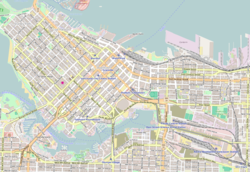Coal Harbour | |
|---|---|
Neighbourhood | |
 | |
Coal Harbour in Vancouver | |
| Coordinates: 49°17′35″N123°07′32″W / 49.29306°N 123.12556°W | |
| Country | Canada |
| Province | British Columbia |
| City | Vancouver |
| Area | |
• Total | 0.573 km2 (0.221 sq mi) |
| Population (2021) [1] | |
• Total | 10,441 |
| • Density | 18,222/km2 (47,190/sq mi) |
| Time zone | UTC-8 (PST) |
| • Summer (DST) | UTC-7 (PDT) |
| Website | coalharbour |
Coal Harbour is a section of Burrard Inlet lying between Vancouver's Downtown Peninsula and the Brockton Point of Stanley Park. It has also now become the name of the neighbourhood adjacent to its southern shoreline.

